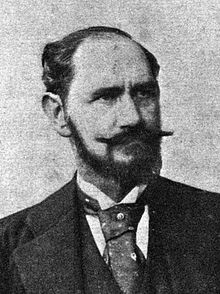Ferdinand Ritter von Mannlicher
| Ferdinand Mannlicher | |
|---|---|
 |
|
| Born |
Ferdinand Karl Adolf Josef Mannlicher January 30, 1848 Mainz, Grand Duchy of Hesse |
| Died | January 20, 1904 (aged 55) Vienna, Austria-Hungary |
| Occupation | Small arms designer, inventor |
| Known for | Inventor of the en-bloc clip |
| Spouse(s) | Caecilie von Mannlicher |
| Awards | |
Ferdinand Ritter von Mannlicher (January 30, 1848 – January 20, 1904) was an Austrian engineer and small arms designer. Along with James Paris Lee, Mannlicher was particularly noted for inventing the en-bloc clip charger-loading magazine system. Later, while making improvements to other inventors prototype designs for rotary-feed magazines, Mannlicher, together with his protégé Otto Schönauer, patented a perfected rotary magazine design, the Mannlicher–Schönauer, which was a commercial and military success.
A scion of a long-established bourgeois family descending from Most (German: Brüx) in Bohemia, Mannlicher was born in the German city of Mainz, where his father served as a k.k. official in the Austrian garrison at the Confederation Fortress. He returned to the Josefstadt district of Vienna with his parents in 1857, and after receiving his Matura high-school exam attended the Vienna University of Technology. He started his professional career in 1869 as an employee of the Austrian Southern Railway company and worked as an engineer at the Emperor Ferdinand Northern Railway company until 1887.
Mannlicher had early turned his interest to weapons technology, particularly breech-loading repeating rifles. His ambitions were fueled by the Austrian defeat in the 1866 Battle of Königgrätz, which he traced back to the inadequate equipment of the Imperial and Royal Army. In 1876 he travelled to the Centennial Exposition in Philadelphia to study numerous construction designs and afterwards drafted several types of repeating rifles with tubular magazines. In 1885/86 he patented the "Mannlicher System" of a breechblock on a bolt action basis, which was adopted as a service rifle by the Austro-Hungarian Army and several other armed forces.
...
Wikipedia
